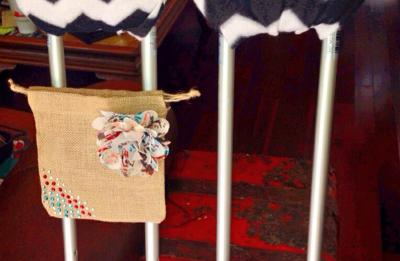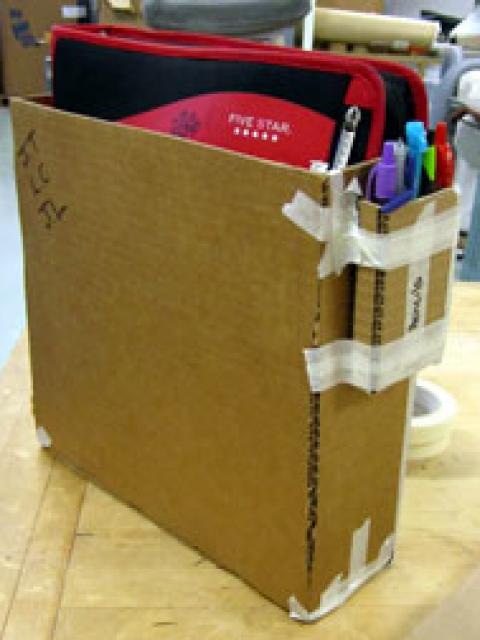Crutch Caddy: Project Overview

Submitted by: Thomas Oliva; Terri Camesano; Kristen Billiar, RET Program, Department of Biomedical Engineering, Worcester Polytechnic Institute
- Equipment Used: Power Tools, Hand Tools, General Fabrication Lab Equipment
- Time Required: 675 minutes (five 50-minute classes per week x 3 weeks)
For this project, students are given a biomedical engineering challenge, which they solve while following the steps of the Engineering Design Process. In a design lab environment, student groups design, create, and test prototype devices that help people using crutches carry things, such as books and school supplies. The assistive devices must meet a list of constraints, including a device weight limit and minimum load capacity.
Students use various hand and power tools to fabricate the devices. They test the practicality of their designs by loading them with objects and then using the modified crutches in the school hallways and classrooms.
Scenario, Criteria and Constraints
Have you ever had an injury of your leg or foot that required you to use crutches for a few days, or maybe weeks or months? What was it like to use crutches? (Direct students to conduct a think-pair-share on this topic. Then listen to a few student stories.) Even if you have not used crutches yourself, you have probably seen or known someone who has used them.
Now, imagine that you need to use crutches during the school year when you cannot just lounge around at home all day recuperating. Living a somewhat normal life with your injury is important because life does not stop when you get hurt. You would need to figure out a way to get around on your crutches all day, to and from school and from class to class, using both of your arms and hands to manipulate the crutches and still carrying anything you needed for the day. What might your needs for your school day be? (Listen to student ideas.) Perhaps books, binders, notebooks, pens, pencils, calculator, and maybe even keys, a cell phone, and your lunch!
Another consideration is that in many schools, backpacks are not allowed in classes. How would you carry these supplies if your hands are not free and a backpack cannot be used? It means that you would need a device to assist you when carrying the things you need each day to class.
To start, let’s clearly state our engineering design challenge: To design a device to enable a person on crutches to carry books and small objects. As with all engineering projects, we must first understand any design requirements and limitations. You might want to write these down in your design journal.
Students' assistive devices must:
- Attach to an individual or pair of crutches.
- Be safe to use.
- Be completed in three weeks.
- Be able to carry a minimum of four pounds.
- Weigh less than two pounds.
Materials
For this project, students generate their own list of materials and tools. They are given no restrictions on the type of materials they choose other than meeting the project constraints for weight and safety, which serve to minimize the size and amount of materials necessary for the activity. Students may bring in their own materials to supplement the teacher-provided materials. Be sure to specify whether it is permitted for students and parents to buy materials or limit their contributions to recycled materials.
- Computers with Internet access and Microsoft PowerPoint software.
- Pencils and paper or notebook.
- Measuring rulers or tape measures.
- Materials and fasteners for device fabrication, such as various woods, plastics, metals, cardboard and fabric, string, rope, nails and screws, nuts and bolts, staples, clamps, Velcro, zip ties, etc.
- Hand Tools for cutting, shaping, forming, joining, fabricating, assembling and finishing designs, such as power/hand saws and drills, hammers, screwdrivers, drills, duct tape, glue suitable for the materials, sewing machine or needles and thread, etc.
- Scale, for measuring weight up to five pounds.
- Pair of crutches, one per group (if enough are available).
- Safety glasses, at least one pair per group, depending upon the tools used.
- Ear protection can be shared among groups, depending upon the tools used.
Learning Outcomes
After completing this activity, students should be able to solve an open-ended design problem, use the Engineering Design Process to solve a problem, and develop multiple solutions to a design problem.





